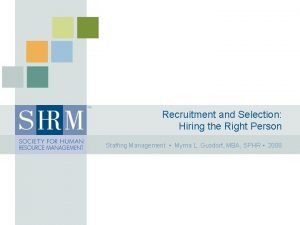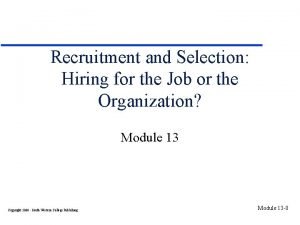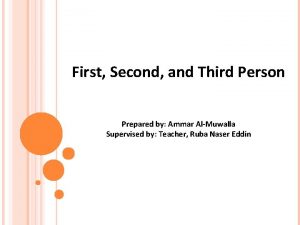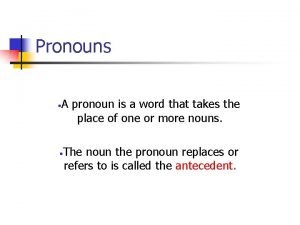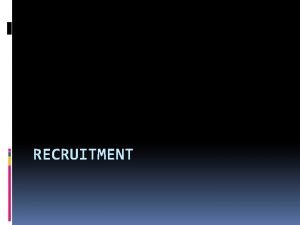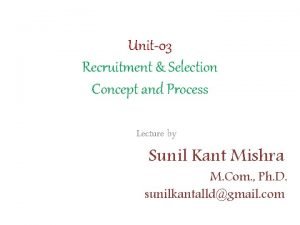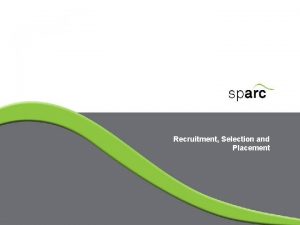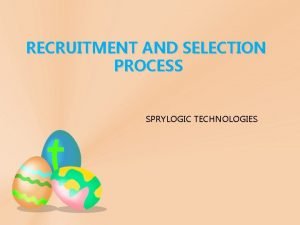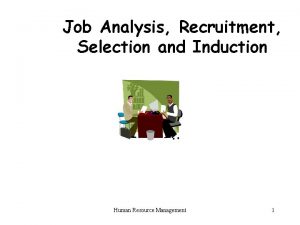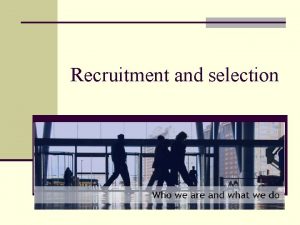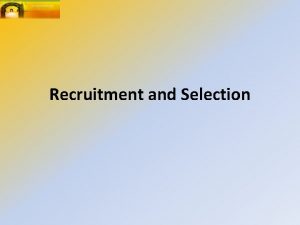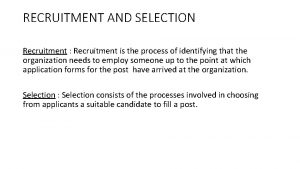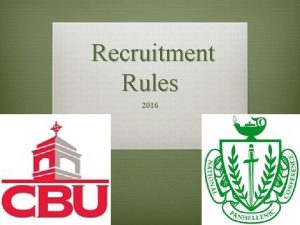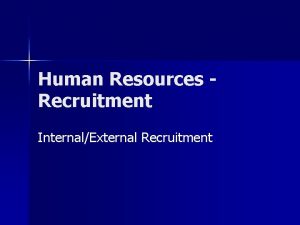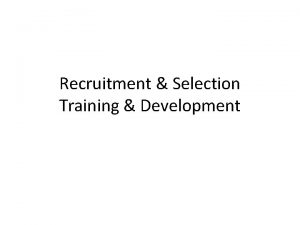Recruitment Selection Lecture 5 Hiring the Right Person


















- Slides: 18

Recruitment & Selection Lecture 5

Hiring the Right Person: Recruitment • RECRUITMENT – The process of attracting individuals in sufficient numbers with the right skills and at appropriate times to apply for open positions within the organization.

Alternatives to Recruitment – Outsourcing. – Contingent labor. – Part-time employees. – Overtime.

Internal Environment • Promotion from within: – Advantages: • Promotion as a reward for good work. • Motivational tool for other employees. • Promoted employee gets up to speed must faster in his or her new job. – Disadvantages: • Must fill the position vacated by the promoted employee. • Lack of new ideas and creativity that may come from a new person. • Jealousy from those not promoted.

Internal Environment • Nepotism: Hiring relatives. – Does your organization have a policy on nepotism? – May be discriminatory. – Must ensure individuals are not in supervisory positions managing their own relatives. – May create issues of favoritism.

External Environment • Labor market conditions: – Strong economy = difficulty hiring. – Weak economy = too many applicants.

External Recruitment • • Employment agencies. Executive search firms. In-house recruiters. Local advertising: – Newspaper. – Multimedia. Internships. Job fairs. College recruiting. Walk-in candidates.

Internet Recruiting • Advantages: Inexpensive. Quick and easy to post announcement. Responses arrive faster and in greater quantity. Will generate a wider range of applicants. Applicants can be screened by computer. Some selection tests can be administered by computer. – Automated applicant tracking. – – – • Disadvantages: – Ease of submission will result in a lot of applicants, many whom are not qualified. – May take more HR time to sort through the greater quantity of applicants.

Selection Tests • SELECTION TEST: Any instrument that is used to make a decision about a potential employee. (1) • STANDARDIZATION: Uniformity of procedures and conditions related to administering tests. (2) • RELIABILITY: The extent to which a selection test provides consistent results. (2) • VALIDITY: The extent to which a test measures what it claims to measure. (2) (1) Myrna L. Gusdorf (2) R. Wayne Mondy

Kinds of Selection Tests • Cognitive aptitude tests measure reasoning, vocabulary, verbal and numeric skills. • Job knowledge tests measure knowledge regarding a particular job. • Work sample tests allow candidates to demonstrate how they would work on the job. • Psychomotor abilities tests assess the skill level of tasks required on the job. • Personality tests assess traits and personal characteristics. They are used to determine if the applicant is the right fit for the organization. • Vocational interests tests identify occupations in which the candidate is most interested. • Honesty and integrity tests try to measure a candidate’s truthfulness.

Interviewing Candidates • Team or individual interviewer? • Structured or patterned interview: – Pre-set questions asked of all candidates. • Nondirective interview: – Minimum of questions, not planned in advance. – Open-ended questions; interviewer follows the candidate’s lead. • Situational and problem-solving interview: – Candidate describes how he or she would solve a problem. • Behavioral interview: – Candidate describes how he or she responded to a specific situation.

Background Verification and Reference Checks • The importance of checking: – 40 percent of applicants lie about work histories and educational backgrounds. – 20 percent of applicants falsify credentials and licenses. – 30 percent of applicants make misrepresentations on their resumes.

The Job Offer • Making the job offer: – May be done by phone, letter or in person. – Make arrangements for further conditions: • Physical exam and drug screen. – Discuss salary and benefits: • Avoid quoting an annual salary. – Realistic job preview, – Verify employment eligibility: • I-9 form.


Evaluating the Recruitment and Selection Process • Cost: – Did you stay within your recruitment budget? • Time: – How long did it take you to fill the position? • Quality: – Were your applicants well qualified for the job? • Longevity: – What about turnover? Do your new hires stay for the long term?

STAFF ORIENTATION AND INDUCTION • Staff are the backbone of a service, so it is important that they are well prepared, presented and informed. Staff induction is the process by which you introduce a new staff member to their physical surroundings, responsibilities and relevant people. • Effectively orienting new employees to the campus and to their positions is critical to establishing successful, productive working relationships. The employee's first interactions with you should create a positive impression of your department and the campus. The time you spend planning for the new person's first days and weeks on the job will greatly increase the chance for a successful start.

Orientation is generally the informal information. Provide staff with an orientation package that will allow a new staff member to explore what their role will be within the service, and provide them with reference material on employment conditions, job description, grievance procedures and any other relative service information. Include a staff handbook with policy and procedural information that covers items relating to the staff members position. Design a checklist of items to address during orientation that will ensure you don’t forget anything. This may consist of such items as: § Introduction to other staff members, management etc. § Philosophy, policies and expectations of the service § Facilities/layout (area utilized by the service) § Lunch/tea breaks § Pay arrangements (award, day, bank transfers, deductions) § Encouraging ongoing communication q § Questions (who to ask, how to ask, confidentiality).

CONGRATULATIONS! You have a new employee!
 Selection in staffing
Selection in staffing Right product right place right time right price
Right product right place right time right price Family time
Family time Recruitment and selection definition
Recruitment and selection definition Difference between hiring and recruitment
Difference between hiring and recruitment The right man on the right place at the right time
The right man on the right place at the right time 2 person singular
2 person singular Speak in 3rd person
Speak in 3rd person Person person = new person()
Person person = new person() I, you, he, she, it, we, they sentences
I, you, he, she, it, we, they sentences What is recruitement
What is recruitement 01:640:244 lecture notes - lecture 15: plat, idah, farad
01:640:244 lecture notes - lecture 15: plat, idah, farad Recruitment meaning
Recruitment meaning What is staffing process
What is staffing process Recruitment and selection course outline
Recruitment and selection course outline Recruitment and selection definition
Recruitment and selection definition Difference between recruitment and selection
Difference between recruitment and selection Recruitment selection and induction policies and procedures
Recruitment selection and induction policies and procedures Job analysis recruitment and selection
Job analysis recruitment and selection
